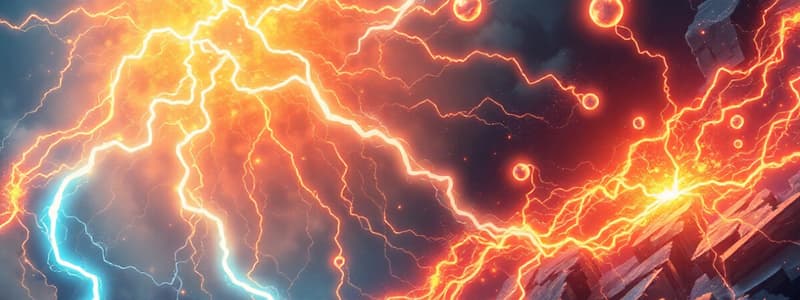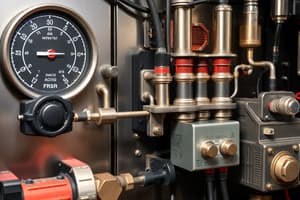Podcast
Questions and Answers
What is the unit of measurement for reactive power?
What is the unit of measurement for reactive power?
- Volt-amperes reactive (VAR) (correct)
- Watts (W)
- Watt-hours (Wh)
- Volt-amperes (VA)
Which of the following components primarily absorbs reactive power in an AC circuit?
Which of the following components primarily absorbs reactive power in an AC circuit?
- Capacitor
- Diode
- Resistor
- Inductor (correct)
In the context of AC power, what does the power factor represent?
In the context of AC power, what does the power factor represent?
- The ratio of real power to apparent power. (correct)
- The amount of energy stored in reactive components.
- The phase angle between voltage and current.
- The ratio of apparent power to reactive power.
Given an AC circuit with a voltage of 120V and a current of 5A, and a phase angle of 30 degrees between voltage and current, what is the real power?
Given an AC circuit with a voltage of 120V and a current of 5A, and a phase angle of 30 degrees between voltage and current, what is the real power?
An AC circuit has a real power of 1000W and a reactive power of 500 VAR. What is the apparent power?
An AC circuit has a real power of 1000W and a reactive power of 500 VAR. What is the apparent power?
An electrical load is described as having a lagging power factor. Which of the actions could improve the power factor of this load?
An electrical load is described as having a lagging power factor. Which of the actions could improve the power factor of this load?
What power factor value indicates that the voltage and current are perfectly in phase?
What power factor value indicates that the voltage and current are perfectly in phase?
What is the typical method for achieving power factor correction in circuits with inductive loads?
What is the typical method for achieving power factor correction in circuits with inductive loads?
What distinguishes a 'lagging' power factor?
What distinguishes a 'lagging' power factor?
Flashcards
Instantaneous Power
Instantaneous Power
Power at a specific instant in time. Calculated as p(t) = v(t) * i(t). Can be positive (source to load) or negative (load to source).
Real Power (Average Power)
Real Power (Average Power)
The average power consumed over one cycle. It's the actual power used to do work, measured in watts (W).
Reactive Power
Reactive Power
Power associated with energy stored in inductors and capacitors. Measured in volt-amperes reactive (VAR). Doesn't do actual work.
Apparent Power
Apparent Power
Signup and view all the flashcards
Power Factor (PF)
Power Factor (PF)
Signup and view all the flashcards
Phase Angle (θ)
Phase Angle (θ)
Signup and view all the flashcards
Power Triangle
Power Triangle
Signup and view all the flashcards
Reactive Components
Reactive Components
Signup and view all the flashcards
Power Factor Correction
Power Factor Correction
Signup and view all the flashcards
Complex Power (S)
Complex Power (S)
Signup and view all the flashcards
Wattmeter vs Power Analyzer
Wattmeter vs Power Analyzer
Signup and view all the flashcards
Three-Phase Power
Three-Phase Power
Signup and view all the flashcards
Balanced Three-Phase System
Balanced Three-Phase System
Signup and view all the flashcards
Wye (Y) or Delta (Δ) Connection
Wye (Y) or Delta (Δ) Connection
Signup and view all the flashcards
Fourier Analysis (Power)
Fourier Analysis (Power)
Signup and view all the flashcards
Transmission/Distribution Goals
Transmission/Distribution Goals
Signup and view all the flashcards
Reactive Power Compensation
Reactive Power Compensation
Signup and view all the flashcards
Study Notes
- Power in AC circuits differs significantly from DC circuits due to the alternating nature of voltage and current.
- Understanding AC power requires considering concepts like instantaneous power, average power, reactive power, and apparent power.
Instantaneous Power
- Instantaneous power p(t) in an AC circuit is the product of instantaneous voltage v(t) and instantaneous current i(t): p(t) = v(t) * i(t).
- For sinusoidal voltage and current, instantaneous power fluctuates over time, and can be both positive and negative.
- Positive instantaneous power indicates energy flow from the source to the load.
- Negative instantaneous power indicates energy flow from the load back to the source.
Average or Real Power
- Real power, also known as average power or active power, is the average of instantaneous power over one cycle.
- It represents the actual power consumed by the load, dissipated as heat or used to do work.
- Real power is denoted by P and measured in watts (W).
- For a sinusoidal AC circuit, real power is given by P = V * I * cos(θ), where V and I are voltage and current, and θ is the phase angle between them.
- The term cos(θ) is known as the power factor (PF).
Reactive Power
- Reactive power is associated with energy stored in and released from reactive components like inductors and capacitors.
- It is denoted by Q and measured in volt-amperes reactive (VAR).
- For a sinusoidal AC circuit, reactive power is given by Q = V * I * sin(θ).
- Reactive power does not contribute to actual work done by the load.
- Inductors absorb reactive power, causing the current to lag the voltage.
- Capacitors supply reactive power, causing the current to lead the voltage.
Apparent Power
- Apparent power is the product of the RMS voltage and RMS current
- It is denoted by S and measured in volt-amperes (VA).
- Apparent power is given by S = V * I, where V and I are the RMS values of voltage and current, respectively.
- Apparent power represents the total power flowing in the circuit, regardless of the phase relationship between voltage and current.
- Apparent power is related to real and reactive power by S² = P² + Q².
- It can be visualized using the power triangle, where S is the hypotenuse, P is the adjacent side, and Q is the opposite side.
Power Factor
- Power factor (PF) is the cosine of the phase angle (θ) between voltage and current.
- It indicates how effectively apparent power is used to do real work.
- PF ranges from 0 to 1.
- A power factor of 1 (unity) indicates voltage and current are in phase, and all apparent power is real power (ideal).
- A power factor of 0 indicates voltage and current are 90 degrees out of phase, and all power is reactive (highly undesirable).
- Leading power factor: current leads voltage (typically in capacitive circuits).
- Lagging power factor: current lags voltage (typically in inductive circuits).
Power Factor Correction
- Power factor correction improves the power factor by reducing the phase difference between voltage and current.
- It is typically achieved by adding capacitors to an inductive load or inductors to a capacitive load.
- Improving the power factor reduces current flow for the same real power, reducing losses and improving voltage regulation.
- Utilities often charge penalties for low power factors, making power factor correction economically beneficial.
Complex Power
- Complex power, denoted by S, combines real power (P) and reactive power (Q) in a single expression.
- It is given by S = P + jQ, where j is the imaginary unit.
- The magnitude of the complex power is the apparent power (|S| = S).
- The angle of the complex power is the power factor angle (θ).
- Using complex power simplifies power calculations in AC circuits, especially when dealing with multiple loads or complex impedances.
- Complex power can also be expressed as S = V * I*, where V is the phasor voltage and I* is the complex conjugate of the phasor current.
Power Measurement
- Power in AC circuits can be measured using instruments like wattmeters, power analyzers, and energy meters.
- Wattmeters measure real power directly.
- Power analyzers measure voltage, current, phase angle, real power, reactive power, apparent power, and power factor.
- Energy meters measure energy consumed over time, typically in kilowatt-hours (kWh).
- Digital power meters and analyzers often provide more accurate and detailed measurements than analog instruments.
Three-Phase Power
- Three-phase power systems are commonly used for distributing power to industrial and commercial customers.
- In a balanced three-phase system, the three voltages are equal in magnitude and 120 degrees out of phase.
- The total real power is given by P = √3 * V_L * I_L * cos(θ), where V_L is the line-to-line voltage, I_L is the line current, and θ is the phase angle between the phase voltage and phase current.
- Three-phase power systems can be configured in either a wye (Y) or a delta (Δ) connection.
- Advantages include higher power capacity, smoother torque in motors, and reduced conductor size compared to single-phase power.
Power in Non-Sinusoidal Waveforms
- When waveforms are non-sinusoidal, power calculations become more complex.
- Non-sinusoidal waveforms can be represented as a sum of sinusoidal components using Fourier analysis.
- The total real power is the sum of the real power contributions from each harmonic component.
- The power factor is not well-defined, and metrics like total harmonic distortion (THD) are used to characterize waveform quality.
- Special power analyzers are required to accurately measure power in circuits with non-sinusoidal waveforms.
Practical Considerations
- Transmission and distribution involve minimizing losses and maintaining voltage regulation.
- Reactive power compensation is crucial for reducing losses and improving voltage stability.
- Power quality issues like voltage sags, voltage swells, and harmonics can affect sensitive equipment.
- Proper grounding and shielding are essential for ensuring safety and preventing electromagnetic interference.
Studying That Suits You
Use AI to generate personalized quizzes and flashcards to suit your learning preferences.





